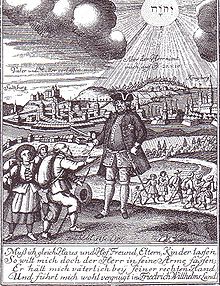Salzburg Protestants
You can help expand this article with text translated from the corresponding article in Bavarian. (December 2017) Click [show] for important translation instructions.
|

The Salzburg Protestants (
Background
The prince-Archbishopric of Salzburg was an
Defereggen Valley expulsion
In 1684, Prince-Archbishop
Contemporary documents capture the expulsion of 621 adults and 289 children from the Defereggen Valley. After five years of wrangling, Emperor
Final expulsion in 1731
In 1731, Prince-Archbishop
Firmian's edict clearly defeated the terms of the Peace of Westphalia. Bowing to pressure from the Protestant estates, the archbishop modified the order to allow families to stay until 23 April 1732 and to retain their property for three years.[3]: 61–64
Before the expulsion order had been issued, the Salzburg Protestants had dispatched delegations to seek help from Protestant princes within the Empire. In August 1731, a delegation set out for Regensburg to seek help from the Protestant body in the Imperial Diet. Another delegation reached Berlin in November 1731, where they were questioned by the Prussian authorities on matters of religious doctrine. The Prussian government subsequently declared that the Salzburgers were bona fide Lutherans who were entitled to the protection of the Peace of Augsburg.[3]: 67–72
Emigration to Prussia

King
Emperor Charles VI, who needed the support of the Protestant states to secure the Austrian succession, wrote a personal letter to von Firmian, asking him to comply with the Peace of Augsburg by allowing the Protestants to leave under reasonable terms and even to remain for three years if they wished.[3]: 128–129 Diplomatic pressure was also exerted on the Habsburg emperor by the Netherlands and Great Britain.[5]: 155 However, the British were reluctant to press too hard, lest the Austrians respond by demanding better treatment for Catholics in Ireland.[5]: 167

Between April and August 1732, over 20,000 Protestants left Salzburg for Prussia, traveling in twenty-six columns of about 800 emigrants each. The Salzburg Protestants were assessed an emigration tax of 10% of their belongings, which they paid upon departure. Among these assets was about 800,000 Prussian thalers in cash. The emigrants were received by Prussian commissioners, who supplied them with travel money. The migration became a spectacle in the Protestant towns of Germany, whose residents plied the Salzburgers with food and money as they passed through.[6]: 142–143 Several hundred Salzburgers died in the trek across Germany.
The first Salzburg Protestants reached Königsberg on 28 May 1732. About 16,000 to 17,000 arrived in East Prussia, where they were settled in the Lithuania Minor region, mainly in the area of Gumbinnen (present-day Gusev, Kaliningrad Oblast). King Frederick William I personally greeted the first group of immigrants and sang Protestant hymns with them.[3]: 87–88
Other destinations
Over 30,000 Salzburgers emigrated as a result of the expulsion edict, the majority of them settling in East Prussia. Several hundred found refuge in territories ruled by King George II of Great Britain, including the Electorate of Hanover and the British colony of Georgia, where, at the instigation of the Augsburg preacher Samuel Urlsperger, several Salzburger emigrants led by Johann Martin Boltzius founded the town of Ebenezer.[1][5]: 155–157 [7] About 800 Protestants, mainly miners from Dürrnberg, emigrated to the Dutch Republic,[8] where some of them settled around Cadzand.
Aftermath
The expulsion of the Salzburg Protestants created a sensation in the Protestant states of Europe. At least 300 different books and pamphlets were written about the migration in 1732–1733, celebrating the faith and perseverance of the Salzburgers.[6]: 143–144 Later, Goethe's poem Hermann and Dorothea would adapt a story from the Salzburg migration to the contemporary setting of the French Revolution.
Prussia dispatched Baron Erich Christoph von Plotho to Salzburg to sell the lands that the Protestants had left behind, valued at about 2.5 million Prussian thalers. He was able to sell the properties only at severely depressed prices of one-quarter to one-half the assessed value. Only a small portion of the sales price was paid in cash, and a 10% emigration tax was paid to the Archbishopric. In total, about 300,000 thalers were recovered from the Salzburg properties.[3]: 98–99
Following the Salzburg example, Emperor Charles VI adopted the policy of expelling Protestants from his adjacent
In 1966, Archbishop Andreas Rohracher expressed regret about the expulsions.
Notable descendants
- Agnes Miegel (1879–1964), author
- Franz Schlegelberger (1876–1970), German jurist
- Wernher von Braun (1912-1977), rocket scientist[9]
References
- ^ ISBN 9781107063280.
- ^ Schaitberger, L. "An Historical Perspective of the Salzburg Protestants". Exulanten. Retrieved 2015-07-21.
- ^ ISBN 0-8014-2777-0.
- ^ Schaitberger, Linda. "The Deferegger Exiles and Some Names". Exulanten. Retrieved 2015-07-21.
- ^ ISBN 9781843832416.
- ^ ISBN 9780674023857.
- ISBN 9781451472288.
- ^ "Salzburger Expulsion". Familie Pfaender. Retrieved 2015-07-21.
- ^ "Wernher Magnus Maximilian von Braun family tree". Geneanet. Retrieved 11 October 2020.
Further reading
- David Erdmann, “The Evangelical Salzburgers,” in the Real-Encyklopädie für protestantische Theologie und Kirche, 2nd ed. (Leipzig: J. C. Hinrichs'sche Buchhandlung, 1884), trans. Nathaniel J. Biebert (Red Brick Parsonage, 2018)
- Edict of Expulsion (1731)
See also
- Transylvanian Landler
- Zillertal § History
